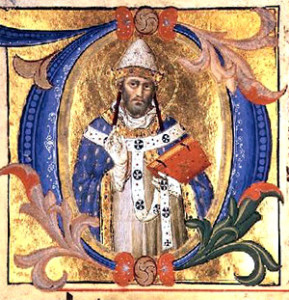Pope Gregory II shares many characteristics with his namesake (and our patron), Pope St. Gregory I. He was born in the year 669 of a noble and wealthy family and his rise to the papacy followed a typical pattern. As a young man, he was ordained Subdeacon and given responsibility for the treasury of the then Pope Sergius I (687-701). Advancing to the dignity of deacon, he was given charge of the Vatican library.
Later, Gregory was made secretary to Pope Constantine and accompanied him to Constantinople in 711. There Gregory handled negotiations regarding the disputed decisions of the Quinisext Council. This Council (held in 692 to make disciplinary canons following the fifth and sixth Ecumenical Councils) had not been attended by any Western representatives and contained several disputed provisions: the prohibition against celebrating Mass (rather than pre-sanctified Liturgy) on weekdays in Lent, of omitting the use of “Alleluia” in Lent, of fasting on some Saturdays, of showing Christ as the “Lamb of God” in art, and particularly of requiring celibacy of all deacons, priests and bishops (one which even the West was not able to enforce until many centuries later). Pope Sergius had refused to sign the decrees of this council, so the talks which Gregory participated in were important for reaching some kind of compromise which the Church in the West could agree to. The Emperor, Justinian II, eventually proposed that any of the canons which violated long-standing practice in the West could be ignored by the churches there. (Although this compromise was not accepted by most in the East, after the centuries of separation which have existed since that time, a more genial approach exists now, and those of us who are Western Rite Orthodox have been given permission to continue most of those long-standing Western practices.)
Dealing with such contentions helped to prepare Gregory for his future as the Pope, which he became in 715 on the death of Constantine. As was true for the earlier Pope Gregory, this pope had responsibilities far beyond the spiritual and theological realm. He first had to deal with flooding in Rome due to the broken walls of the city and the needed repairs, while at the same time responding to the Monothelite views of Patriarch John VI of Constantinople. He had to decree that Thursdays in Lent were fasting days like every other day, since some had not fasted because the pagan followers of Jupiter fasted on that day.
Pope Gregory, like his papal ancestor, was concerned for evangelization beyond the boundaries of what had been the Roman Empire. He helped to establish churches in Bavaria with local leadership. In 718, the Anglo-Saxon monk-missionary Wilfrid, came to him requesting his support for work among the German people. Gregory changed the monk’s name to Boniface and gave his permission for this work. When the mission effort showed success, Pope Gregory made Boniface a bishop in 722 and we now venerate him as St. Boniface, Apostle of Germany.
Gregory had further contact with the Anglo-Saxon world when Ine, the King of Wessex, gave up his rule in order to travel on pilgrimage to Rome to visit the tombs of the saints and to spend the rest of his life there.
Also like Pope Gregory I, Gregory II was interested in promoting monasticism and restoring monasteries that had been destroyed or damaged by the attacks of the Lombards. He gave his family mansion in Rome to be the monastery of St. Agatha.
In Gregory’s lifetime, the political stability of Rome was constantly challenged by the Lombards, which Gregory managed to deal with diplomatically. There were also disputes with the Emperor in Constantinople, particularly after Emperor Leo raised property taxes in Rome to help pay for the war against the Arab Moslems. The money was needed to pay for food in Rome, however, so the pope refused to pay the additional tax. In 726, Leo began his iconoclastic campaign, and this resulted in further unrest among the Roman people and the imperial exarch in Ravenna. Plots were made to revolt against the Emperor, but Gregory urged restraint. However, he was not quiet on the issue of iconoclasm. He wrote to the Emperor denouncing his right, as a political leader, to make doctrinal rulings for the Church and he ridiculed his claim that the people worshiped “stones and walls and boards.” He said that even little school children laughed at that idea!
Leo responded by appointing a new exarch for Ravenna, Eutychius, who was instructed to kill Gregory and other Roman leaders. This plot was foiled but such unrest between the Romans, the Lombards, and the Byzantines continued for the remainder of the pope’s life. Pope Gregory II died on February 11, 731, having served God and his Church faithfully in a time of great turmoil. After his burial in St. Peter’s basilica (a tomb which can no longer be found), he was declared a saint by those who knew and loved him. He is venerated on February 11, the day of his heavenly birthday. May we, who also see political and religious turmoil, take comfort in the intercessions of this saint. Holy Gregory, pray for us.
